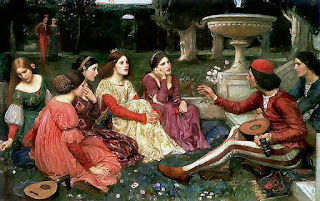Although we know little of his personal life except that he practices in Nottinghamshire and London, his broad knowledge suggests someone who traveled and had a variety of experiences. Since he lived through the Black Death and the Hundred Years' War (during which he saw action in France), he had plenty of opportunities to learn about and deal with a wide variety of illnesses and injuries.
In 1370 he wrote the Practica Chirurgiae ("Practice of Surgery"), in which he detailed many of his techniques and boasted a for-his-time astonishing survival rate of 50%. There are not only detailed instructions, but detailed illustrations of the parts of the body being operated on, as well as illustrations of the instruments (many of which he designed) used.
More than the practical side of things, however, he gave advice to the surgeon open dress and behavior. He urged the university-trained doctor to dress the part, rather than wear the limited short (above the knee) robe of the typical "barber surgeon" (educated in a guild), to appear more important. Barber surgeons were looked down upon, and he advises his readers not to share techniques with them, lest they usurp the position of the university-educated surgeon. In a later century, in Paris, a distinction was made with the titles "Surgeons of the Short Robe" (who could offer their services never having taken an exam or proved their knowledge) and "Surgeons of the Long Robe."
Arderne's advice went beyond haughty classism, however. He also advised a pleasant bedside manner: the doctor should be able to tell tales "that may make þe pacients to laugh" and tales from the Bible to "make or induce a liȝt hert[light heart] to þe pacient or þe sike [sick] man." He should also, when speaking to a patient, not confuse him with complicated terms or harsh language:
“be the wordeȝ short, and, als mich as he may, faire and resonable and withoute sweryng”
make the words short, and, as much as he may, faire and reasonable and without swearing.
He felt that wealthy patients should be charged as much as possible, but poor patients treated for free.
More than 50 copies of his Practica exist today; 36 of them are copies with the original 250 illustrations. The expense of reproducing so many illustrations was significant, but it is a testimony to how valuable the work was considered to be. The illustrations were not only important to show how the body was being treated, but to understand the use of the instruments. These tools of the trade were not readily available, and had to be custom-made. I feel not enough has been said about the relationship of people with specific requests to the metal-workers of the age, so tomorrow let's talk a little about the blacksmith trade.



















